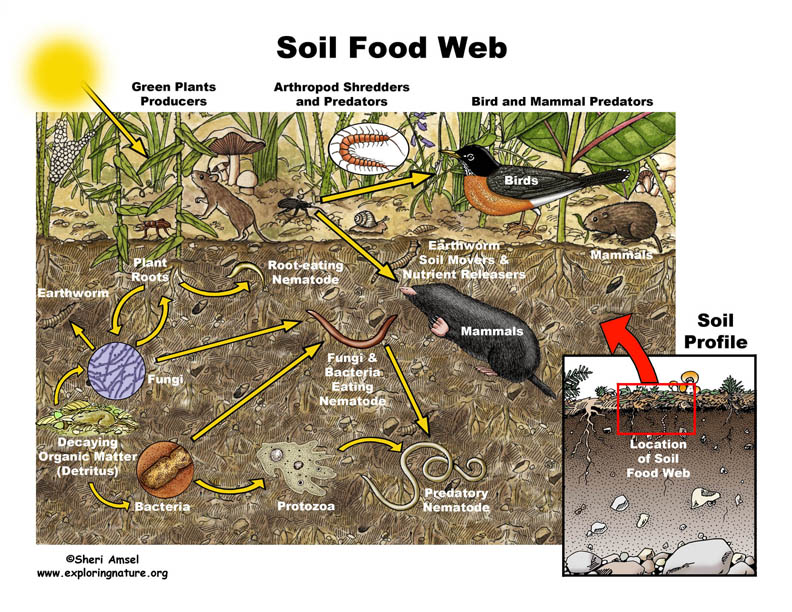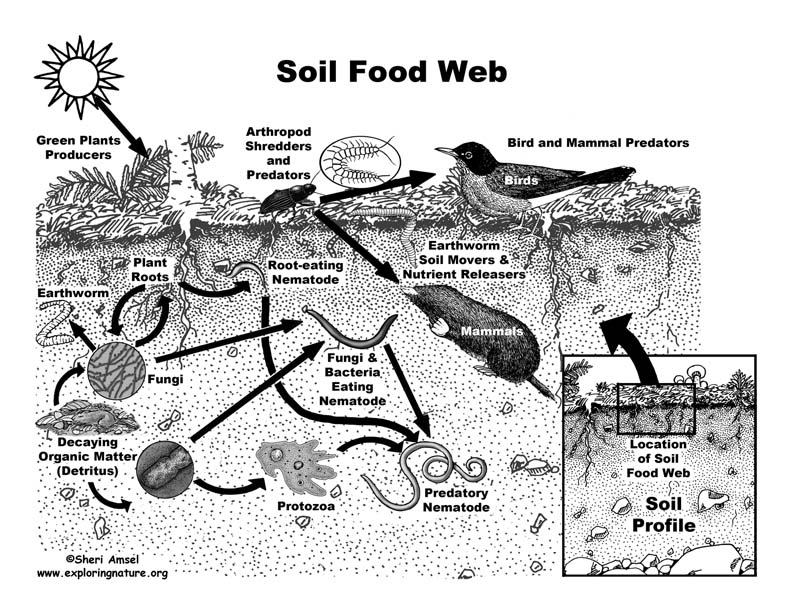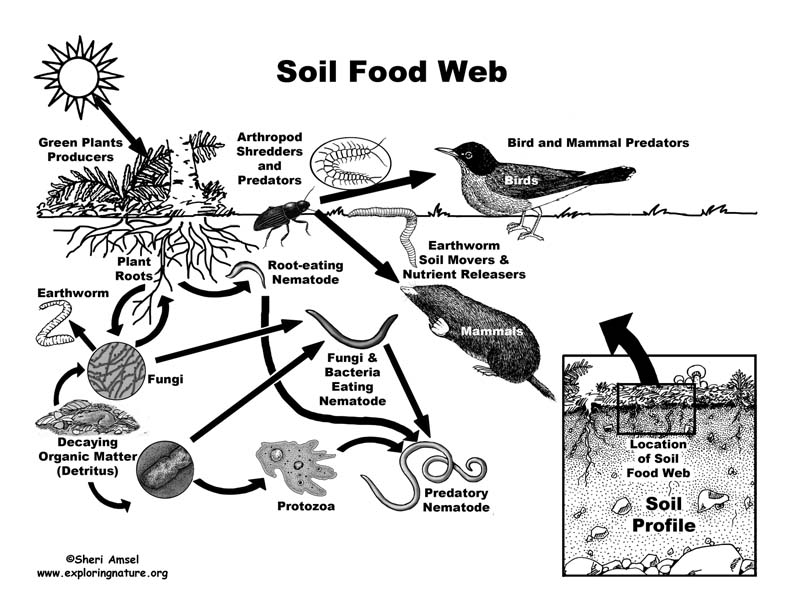

Energy flows through an ecosystem as plants turn sunlight into the energy they use to grow. The plants are then eaten by animals. The animals are eaten by other animals. When the plants and animals die, they are broken down by detritivore and decomposers (insects, fungi, and bacteria) into organic matter in the soil that releases nutrients back to fuel the growth of plants. We see this nutrient cycle in deserts, rainforests and grasslands, but one of the most important food webs is one we rarely see – the one in the soil below our feet. The cycling of nutrients in the soil is vitally important though, as terrestrial plants depend on them and in turn are the producers for most food webs on Earth.
Soil is made up of broken down rock and mineral matter mixed with decomposing organic matter (humus) and living organisms. Soil food webs, like all food webs, have producers – green plants, lichens, and photosynthetic bacteria and algae that convert sunlight into energy using photosynthesis. Plants are only available as roots and as part of the decomposing organic matter in the soil. There are also many small microorganisms (bacteria, fungi and protozoa) and larger nematodes, segmented worms, and arthropods that are consumers in the food web. Still larger organisms, such as birds, shrews and rodents also play a role as higher level consumers. The organisms cycle nutrients through the soil as in any other ecosystem food web.
Why Soil is Important
Besides for cycling nutrients for green plants, soil has many other important functions in healthy ecosystems.
1) The many organisms in soil act as an army of decomposers for the waste of live above. They break down dead organisms (animal and plant) and animal waste (feces or manure). The decomposition of organic matter helps not only replace nutrients used in growing new plants but helps replace the soil lost to erosion and weathering.
2) Soil organisms are food for the animals above (robins eating earthworms, rodents eating invertebrates, etc.
3) The organisms and matter in the soil act to filter water moving through the water cycle, so that it is cleaner by the time it reaches groundwater aquifers, rivers, lakes and the ocean. They can also break down chemicals and materials carried in runoff.
4) The soil also traps the nutrients brought by water to use in its complex nutrient cycle.
5) Soil organisms (including the nodules on the roots of leguminous plants) “fix” nitrogen from the atmosphere making it available for plant use.
6) Soil organisms like the earthworm help – through feeding and movement – to fluff up the organic matter of the soil making it looser for root growth, water and air movement instead of a hard barrier. Soil with enough organic matter (humus) holds onto moisture longer to prevent drying out. Healthy soil can be made up of as much as 80% humus.
7) Soil is where we grow our food (crops) and the food for our agricultural animals. Soil can be depleted of nutrients, eroded and polluted by inappropriate agricultural practices. This is an ongoing concern of soil scientists.
Soil Food Web Organisms
1) Bacteria are single-celled microorganisms that can be important decomposers and also act to filter and break down some pollutants. There are millions of soil bacteria in every ounce of soil.
2) Protozoa are another single-celled microorganism or microbe that eat bacteria. In the soil food web, they eat bacteria, release ammonium and are food for nematodes.
3) Fungi are in the same Kingdom as mushrooms, yeasts and molds. Their grow through the soil in long filamentous runners called hyphae. The beneficial fungi are decomposers, helping to bulk up the organic matter of the soil. They can also help to break down some pollutants.
4) Nematodes are in the Phylum of Round Worms. Most are beneficial to the soil ecosystem feeding on bacteria, fungi and other harmful nematodes. The harmful nematodes are root eaters and damage plants.
5) Earthworms are in the Phylum of Segmented Worms. They are beneficial to the soil ecosystem by decomposing organic matter and releasing the nutrients for plants to use. They also move through the soil making it looser for root growth, water and air movement. Soil with enough organic matter (humus) holds onto moisture longer to prevent drying out.
6) Arthropods is the Phylum that includes insects, spiders, mites, scorpions, centipedes and millipedes. The arthropods found in soil ecosystems can range from too small to see with the naked eye (mites) to a 8-inch long giant millipede. Arthropods benefit the soil by shredding organic matter that can then be more easily decomposed. Examples of shredders are millipedes, sow bugs, termites, roaches and some species of mite. They also burrow, so move organic matter around in the soil. Harmful arthropods feed on plant roots.
For more information about soil ecosystem (off site) go to the USDA soils site or the Colorado State University Extension site.
When you research information you must cite the reference. Citing for websites is different from citing from books, magazines and periodicals. The style of citing shown here is from the MLA Style Citations (Modern Language Association).
When citing a WEBSITE the general format is as follows.
Author Last Name, First Name(s). "Title: Subtitle of Part of Web Page, if appropriate." Title: Subtitle: Section of Page if appropriate. Sponsoring/Publishing Agency, If Given. Additional significant descriptive information. Date of Electronic Publication or other Date, such as Last Updated. Day Month Year of access < URL >.
Amsel, Sheri. "Soil Food Web" Exploring Nature Educational Resource ©2005-2024. December 13, 2024
< http://www.exploringnature.org/db/view/Soil-Food-Web >


